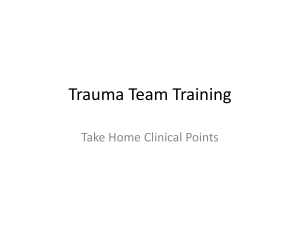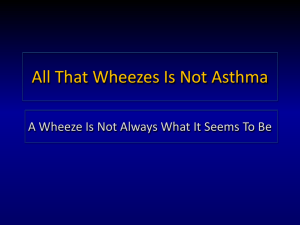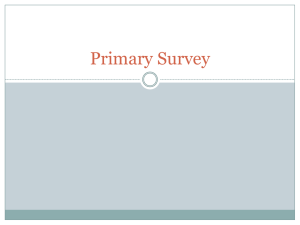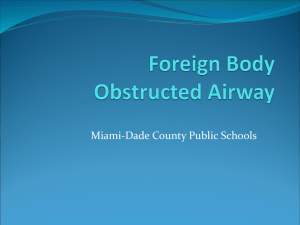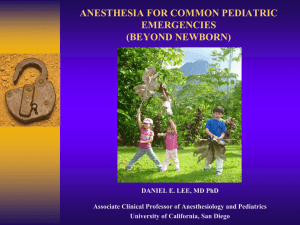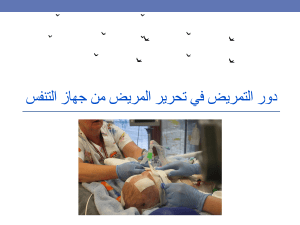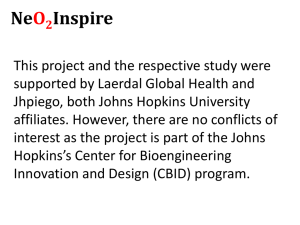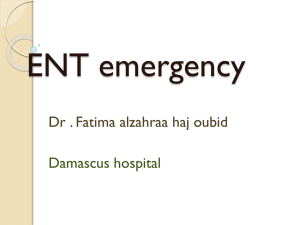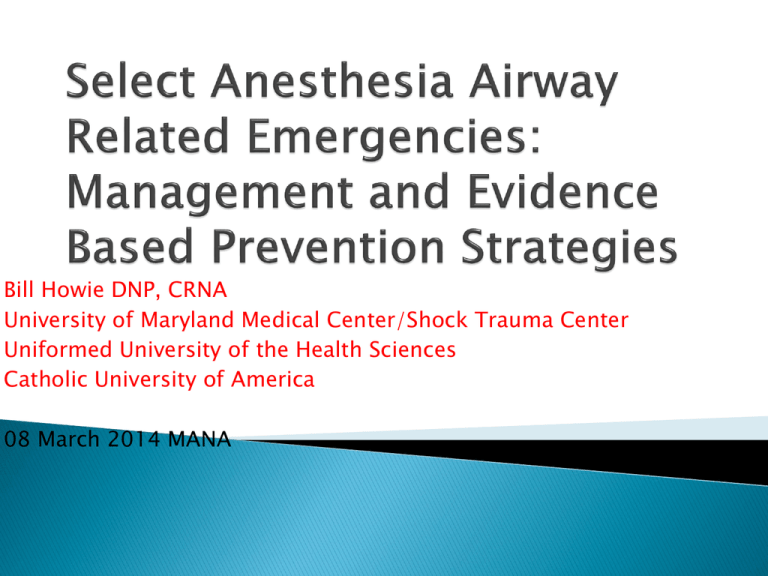
Bill Howie DNP, CRNA
University of Maryland Medical Center/Shock Trauma Center
Uniformed University of the Health Sciences
Catholic University of America
08 March 2014 MANA
Following this presentation the participant
will:
◦ Discuss strategies to prevent adverse patient
outcomes when faced with: An unrecognized
difficult airway; an acutely injured trauma patient;
a patient at risk for aspiration; a patient at risk for
an airway fire ; a patient with an airway obstruction;
and an unintended endobronchial intubation.
Complications arising from difficult or failed
tracheal intubation remain a leading cause of
anesthetic morbidity and mortality, despite
the advent of recent developments in airway
management strategies (Langeron et al.
2006; Malik, et al. 2009; Hagberg 2013)
Physical exam: mouth opening, teeth (or
tooth) configuration? neck mobility ,
thyromental distance, jaw mobility, tongue
size, length of neck, neck scars (old trach,
neck surgeries?), evidence of previous
radiation therapy or a history of such?
History : no prior radical head and neck
surgeries? No history of obstructive sleep
apnea (redundant tissue)
Preop exam written by others? Always do
your own airway exam on all patients!
ASA Practice Guidelines for management of the difficult airway
(2013) Anesthesiology: 118(2) pp 1-20.
Berkow, L. What’s new in airway management (2013) ASA
Refresher Course: 41(1) pp 31-37.
Berkow, L. What’s new in airway management (2013) ASA
Refresher Course: 41(1) pp 31-37
It has been defined as the clinical situation in
which a conventionally trained anesthetist
experiences difficulty with face mask ventilation ,
difficulty with tracheal intubation, or both ( ASA
2003)
Much study has been conducted to identify
strategies to deal with this significant anesthesia
and critical care problem (Airway examination
techniques , airway adjuncts, airway rescue
devices, airway practice simulators, emergency
surgical airways, difficult airway workshops and
the like)
An observational study of 94,630 anesthetics
performed 2004 to 2008 was completed
53,041 operations included an attempt at
mask ventilation. 77 patients (0.15%) were
noted to be impossible to ventilate (incidence
of 1: 690)
19 (25%) of the patients were noted to be a
difficult intubation
15 of these were intubated
4 were not (2 surgical airways and 2 were
awakened and a fiberoptic was done)
Factors linked to the difficulties were:
◦ Neck radiation changes (the most significant clinical
predictor in this review)
◦ Male sex
◦ Sleep apnea
◦ Mallampati III or IV
◦ Presence of a beard
Kheterpal S., et al. (2009) Prediction and outcomes of
impossible mask ventialtion. Anesthesiology 110(4):
pp 891-897.
The most frequent cause of maternal death in
the UK was failed intubation (50 of 103
reported deaths from 1976-2005)
The authors collected data from 2000-2007
and reported a total of 55,057 deliveries
Difficult intubation was reported in 23 of
3430 patients (1:156 patients)
14 cases (61%) were unanticipated difficult
intubations
Risk factors to explain the unrecognized difficult
intubation were noted to be due to an inadequate
preop assessment:
◦ no recorded assessment (6 cases)
◦ poorly documented airway exam(8 cases)
◦ 7 patients were overweight
◦ 2 of the patients had a BMI > 35
All patients were successfully intubated primarily with a
bougie
The authors noted that the low rate of general anesthetic
in OB does not allow providers adequate experience in
airway management. And, a thorough airway exam is
essential to provide a safe anesthetic
Djabatey EA., & Barclay PM. (2009) Difficult of failed intubation in 3430
general anesthetics. Anaesthesia 64(11) pp 1168-1171
When applied in accordance with a predefined
algorithm, the gum elastic bougie and the
ILMA™ are effective to solve most problems
occurring during unexpected difficult airway
management (Combes et al. 2004)
Other studies have noted potential improved
success using alternative adjuncts (Bullard ,
retrograde wire, LMA Ctrach, Airtraq
Laryngoscope, LMA-Fastrach, and the
Glidescope) (Rich 2005; Malik et al 2009)
An algorithm for airway management that incorporates Gum Elastic Bougie (GEB), LMA-CT,
and AQ-L devices was used in 12,225 anesthetized, paralyzed patients. Successful tracheal
intubation under visual control was achieved in all patients with difficult airways.
The Pentax AWSw laryngoscope demonstrated
more advantages over the Macintosh
laryngoscope than either the Truview EVO2w or
the Glidescope w laryngoscope, when used by
experienced anaesthetists in difficult tracheal
intubation scenarios (Malik et al 2009)
Who in the audience has ever faced an
unrecognized difficult airway?
What strategy worked the best for you?
When faced with the acutely injured trauma
patient the provider must have:
◦ All necessary airway and anesthesia equipment
immediately available and checked for function
◦ An understanding of the basic “rules of trauma” (full
stomach, potentially hypovolemic, potentially
closed head injured, potentially c-spine injured,
potentially premedicated, etc)
◦ Enough help immediately available to handle the
airway (how many people do you need?)
◦ A clear plan regarding management of the airway
(Bailitz et al 2011)
6088 patients admitted to the STC required
intubation within the first hour, 21(0.3%)
received a surgical airway. During the first 24
h, 10 more patients (n=31), received a
surgical airway, during approximately 32,000
attempts (0.1%). Unanticipated difficult upper
airway anatomy was the leading reason for a
surgical airway. Four of the 31 patients died
of their injuries but none as the result of
failed intubation. (Stephens et al: 2009)
Rapid sequence induction followed by direct
laryngoscopy is a remarkably effective
approach to emergency airway management.
An algorithm designed around this approach
can achieve very high levels of success
(Stephens et al: 2009)
Difficult mask ventilation: presents as the
inability to provide adequate face mask
ventilation due to inadequate mask seal,
excessive gas leak, or excessive resistance to
gas flow
There are five independent predictors for
difficult mask ventilation: age > 55, BMI >
26, presence of a beard, edentulous , and a
history of snoring (Bhavani et al, 2011)
The inability to adequately ventilate your patient
makes this a true life threatening emergency
Uniform application of a difficult airway
algorithm might decrease the incidence of
hypoxic brain damage during anesthesia
induction (Amathieu 2011)
Uniform application of a clear algorithm might
decrease patient injury or death in any situation
where airway management turns difficult
Experience in surgical airway techniques is
essential (cricothyroidotomy). Training in such
techniques is mandatory for any organization with
a safety culture. These techniques should be
practiced in workshops and their daily use in
certain ENT and trauma situations is good practice
that provides further experience (Heidegger et al.
2005)
Your facility should have a mechanism to deal with
a failed airway scenario (emergency surgical airway
team? Or just the closest podiatric surgeon?)
Difficult airway cases brought to lawsuit were
reviewed in the ASA Closed Claims Data Base
(n=179 from 1985-1999)
The analysis found that the difficult airway
sentinel events occurred : 67% upon
induction, 15% during surgery, 12% at
extubation, and 5% during recovery (Peterson
et al. ASA 2005)
Persistent attempts to instrument the airway
with the same unsuccessful technique waste
valuable time
A preset difficult airway algorithm is critical. Do
you have the necessary equipment on hand, and
are you comfortable using it?
Call for help early. (The airline industry has
pointed to countless crashes attributed to failure
of crew members to speak-up and note a
problem. Lack of a “safety culture”) (Bhavani et al
2011)
Rapid Sequence Induction: A technique of
inducing general anesthesia to quickly
secure the airway to reduce the risk of
pulmonary aspiration of gastric contents
◦ Indications: Emergency surgery/non-fasting
patients/acute abdomen/paralytic ileus/
reflux/obesity/diabetes/pregnancy
◦ Airway management is the most important skill for
an emergency practitioner to master because failure
to secure an adequate airway can quickly lead to
death or disability
Contraindications: Patients with anticipated
difficult airway
Situations where laryngeal injury suspected
Which muscle relaxant should be used? (Sux, Roc,
Vec, Cisatracurium- or does it matter?)
Roc vs Sux for RSI: Cochrane Review found Sux
created superior intubating conditions (perceived
as excellent. But when less stringent clinically
acceptable conditions used, there were not
statistically significant differences found when
propofol was used to induce (Perry et al 2008)
Rapid Sequence Induction includes specific
separate actions to reduce risk of pulmonary
aspiration:
◦ Administration of a rapid acting IV induction agent
and muscle relaxant simultaneously (classic RSI)
◦ No mask ventilation (classic versus modified?)
◦ Cricoid pressure
◦ Smooth and skillful laryngoscopy (trainees?)
◦ Provision of optimal pre-oxygenation clearly is
recommended whenever possible.
It is key that the provider remembers :
◦ Prepare (assess the airway/have primary and
backup equipment assembled)
◦ Preoxygenate
◦ Paralysis and induction drugs at the same time
◦ Protection (cricoid) (zantac/reglan/bicitra ?)and
positioning (head up or head slightly down?)
◦ Placement of cuffed ETT with proof of ETC02
◦ Post-intubation management (sedation/vent)
The 2008 National Emergency Medical Services
Information System (NEMSIS) Public-Release Data
Set containing data from 16 states was utilized
◦ Among 4,383,768 EMS activations, there were
10,356 Endotrachial Intubations, 2246 alternate
airways, and 88 cricothyroidotomies. ETI success
rates were: overall 6482/8418 (77.0%)
◦ Alternate airway success was 1564/1794 (87.2%).
Major complications included: bleeding 84 (7.0 per
1000 interventions), vomiting 80 (6.7 per 1000) and
esophageal intubation 12 (1.0 per 1000)
Data were collected prospectively for all ETIs
performed by the fire department from 2001–
2005, and included demographics, number of
laryngoscopy attempts, airway procedures,
complications, and outcomes
Of 80,501 ALS patient contacts, 4091 (5.1%)
underwent attempted oral ETI, with a 96.8%
success rate in four or fewer attempts
The difficult airway cohort included 130
patients (3.2%), whose airway management
consisted of oral ETI after more than four
attempts (46%), bag-valve-mask ventilation
(33%), cricothyroidotomy (8%), retrograde ETI
(5%), and digital ETI (1%)
Procedural success rates ranged from 14%
(digital ETI) to 91% (cricothyroidotomy). Nine
patients (7%) had failed airway management,
of whom 5 were found in cardiac arrest
The two most common reasons reported by
ALS providers for airway difficulty were
anterior trachea (39%) and small mouth (30%).
Overall mortality for the difficult airway
cohort was 44%
Patient anatomy was a primary factor in failed
ETI
Among the advanced procedures utilized,
cricothyroidotomy had the highest success
rate and should not be delayed by other
interventions
A systematic review was done (184 clinical
trials) The overall conclusion was that:
◦ There was an absence of evidence to either support
or discourage the use of the RSI technique for the
prevention of aspiration
◦ The use of a modified RSI that permits ventilation
with cricoid after induction may be appropriate in
some situations
◦ Available studies support use of sux due to its speed of
offset since it gives the fastest and best early intubation
conditions (less coughing with early instrumentation)
(Sluga et al 2005). However, higher dose Roc or Vec
provide clinically similar results to sux
◦ Controlled trials are necessary to provide more evidence
to strongly recommend the RSI technique. (Which drugs
are best? (Etomidate vs STP vs Propofol vs Ketamine;
Fentanyl vs Lidocaine to blunt laryngoscopy stimulation)
Bag valve mask ventilation while waiting for agents to
take effect?
◦ (Neilipovitz et al 2007)
Aspiration: Inhalation of material into the
airway below the level of the true vocal cords
The incidence of aspiration in adults is:
◦
◦
◦
◦
◦
1
1
1
1
1
in
in
in
in
in
3000 anesthetics
600-800 emergency surgeries
400-900 C-sections under general anesthesia
2600 for children
400 or emergency surgery in children
Risk Factors: Trauma/Emergency surgeries,
gastroparesis (multiple causes), head injured
/CVA patients (altered gag/swallow/LOC),
GERD, Obesity, Pregnancy, obstruction, lied
about PO intake preoperatively, extremes of
age, impaired LOC due to illicit drugs and or
ETOH, lithotomy and occurrence of a difficult
intubation/difficult airway (Kalinowski 2004;
Sekar et al 2011)
The consequences of aspiration can lead to
situations where patients need > 48 hours of
ventilator/ICU support
Acute lung injury associated with aspiration
produces impaired arterial oxygenation with a
Pa02/Fi02 ratio of < 300
Extreme lung injury may progress to ARDS
and a Pa02/Fi02 ratio of < 200
There is a 50% mortality
(Kalinowski & Kirsch 2004)
Provider related risk factors:
◦ Poor induction technique (Failure to push induction
agents in rapid order if RSI); administration of large
tidal volumes or airway pressure greater than 20cm
H20 during induction (gas insufflation into the
stomach); difficult airway or repeated
laryngoscopies (how many attempts should be
taken to secure the airway? When should trainees
be permitted to manage the airway of actual
patients?)
Provider related risk factors:
◦ Manipulation of the airway during a light stage of
anesthesia leading to gagging/coughing/vomiting
◦ Patient positioning (T-Berg/Lithotomy)
◦ Topicalization of the airway during awake
procedures leading to loss of airway protection
◦ Improper application of cricoid pressure
◦ Administration of ongoing doses of opioids
(anesthesia pain management service)
◦ Inadequate preoperative assessment (forgot to ask
NPO status, or did not appreciate risk factors such
as diabetes, obesity, GERD, etc)
Presentation:
◦ Particulate matter or liquids found in the
oropharynx
◦ Wheezing
◦ Elevated airway pressure
◦ Decreased 02 saturations
◦ Infiltrates on CXR
◦ Signs and symptoms of ARDS
A recent retrospective study looked at 99,441
anesthetic in patients over 18 years of age
from January 2001 through December 2004.
14 cases of confirmed aspiration occurred. 6
of the patients required ICU care. One of
these patients died
Approximately 70% of the cases of aspiration
were the attributed to improper anesthetic
technique
All of the patients had one or more risk
factors for aspiration : esophageal pathology,
previous esophageal surgery, continuous
opioid administration, GI obstruction, recent
PO intake, trauma surgery , impaired
gag/swallowing reflexes, obesity, depressed
LOC
The incidence of perioperative pulmonary
aspiration was 1 in 7103 anesthetics with a
morbidity rate of 1 in 16,573 and a mortality
rate of 1 in 99,441 (Sakai et al 2006)
Patients who aspiration were typically older and
sicker than other patients
They more often underwent emergency surgeries
or abdominal procedures
Death was twice as common in in aspiration
claims as compared to other closed claims
Aspiration typically occurred on induction despite
the use of RSI with cricoid pressure in half of the
claims (raising questions if this technique is
effective to prevent aspiration) (Bailie et al 2010)
Immediate management:
Increase Fi02 to 100%
Position patient head down-suction intraoral
Maintain cricoid pressure?
Intubate with cuffed ETT (if you have not done so
already)
◦ Suction the ETT
◦ Mechanical ventilation with at least 5cm peep
◦ Perform bronchoscopy (diagnostic and therapeutic)
◦
◦
◦
◦
Routine use of steroids not recommended
Antibiotics not recommended unless
diagnosis of pneumonia made
Antacids and prokinetics not shown to
improve outcomes after the aspiration has
occurred
Defer elective surgeries until patient stable
? Ventilator therapy/ICU care
Prevention:
◦ Stress importance of NPO guidelines
◦ Control and secure the airway of any patients with
poor gag reflex or decreased LOC early
◦ Appropriately apply RSI principles (correct drugs in
correct sequence, correct cricoid pressure)
◦ Consider H2 blockers/prokinetics/bicitra and the
like for patients at high risk
◦ Consider awake intubation if difficult airway
anticipated
◦ Effects of Metoclopramide and Ranitidine on
Preoperative Gastric Contents in Day-Case Surgery
(Laproscopic outpatient GYN procedures)
◦ 15 minutes prior to induction of anesthesia 20
patients were given 50mg ranitidine and 10mg
metoclopramide. The pH was on average 6.8 in the
study group vs 1.6 in the control group. The
gastric volume was on average 11ml in the control
group and 4.5ml in the study group (Hong 2006)
A Cochrane review found that drinking clear
fluids as recently as a few hours prior to
surgery did not increase he risk of
regurgitation during or after surgery (Brady et
al. 2003)(Does it actually promote emptying?)
Clearly traumatic injury after eating, obesity,
diabetes, pregnancy, the elderly, and people
with various stomach disorders are still at
greater risk for aspiration
ASA Closed Claims Intraoperative Fires : Kressin 2004
Operating room fires are infrequent but
potentially catastrophic .
Early signs of a fire include: Seeing a flame,
flash, or smoke, unusual sounds, odors, or
feeling actual heat
Communication is vital between anesthesia and
the surgeon regarding use of cautery, placing
drapes over the face/adequate use of suction
to clear the environment of potential fuel
sources and careful titration of oxygen and
N20 . (should N20 be used for surgeries near
face and airway?)
“Death by anesthetic explosion is given heavy
emphasis in the media of public information…it
is the most dramatic of all surgical fatalities”
Rare back in the late 1950s (1 in 100,000
anesthetics)…in the late 1950s ethylene,
cyclopropane, diethyl ether and divinyl ether
were used
Halothane used in the United States 1958 (the
first non-flammable anesthetic agent) It has
been virtually obsolete since 1988 due to
concerns of hepatitis necrosis in some patients
as well as myocardial depression (particularly in
pediatrics) (Giesecke 2008 Bulletin of anesthesia history: 26(2)
First use of Halothane in the United States
Thomas GJ Fire and explosion hazards with flammable
anesthetics and their control. 1960 Journal National
Medical Association: 10(6) 397-403
Ignition of combustible materials ( plastic tracheal tube) in
the airway.
Any fire requires three components : Fuel source (alcohol
prep, plastic tracheal tube); Oxygen, and a source of ignition
(cautery, laser) (approx 50 to 200 OR reported fires/year in
US. 33% in the airway, 28% the face, 39% elsewhere on patient
. 20% result in serious injury or death- ASA 2008, Daane,
2005)
Burn injuries represent 20% of MAC related malpractice
claims, 95% of which involved head/neck surgeries (Rinder
2008)
Disconnect the circuit (Oxygen supply)
Inform the surgeon (they probably already
know)
Remove the ETT/Trach ?
Stop flow of all airway gases (especially
Nitrous Oxide)
Flood the area with fluid (saline or sterile
water)
Reintubate (even if injury to airway not
immediately evident)
Duraprep and the Risk of Fire During
Tracheostomy (Weber, Hargunani, & Wax: 2006. Head and
Neck: 28(7); 649-652.
Duraprep is a surgical prep that contains 0.7%
iodine in a 74% alcohol base. It takes 3
minutes to dry. The solution accumulated in
sufficient amounts to ignite on a 62 year old
man with copious amounts of body hair
posted for a tracheostomy
Weber et al. Duraprep and the risk of fire during
tracheostomy 2006: Head and Neck: 28. 649-652.
Should you extubate the patient for a
presumed airway fire? Does it matter if it
occurs with an ETT in place or during a
tracheostomy?
Special considerations regarding fires involving
tracheostomies require consideration of where
the fire was/is (in airway; on ETT, in superficial
tissue?) is ETT backed out to area waiting for
tracheostomy to be inserted? Must consider how
sick and how difficult to intubate the patent is
(ICU vent dependent, short neck, morbidly obese,
etc) Consider use of a tube exchanger if suspect
ETT damaged prior to insertion of the Trach (Chee,
Benumof 1998 Airway Fire during Tracheostomy: Extubation may
be contraindicated. Anesthesiology: 89(6). 1576-1578.
Avoid situations that increase fire risk
(alcohol preps/use holsters for cautery/keep
audibles tuned up on cautery devices/keep
surgeons aware of where foot switches are,
do not turn off audible that device is being
used)
Always have plan of action if fire occurs(have written plan of action displayed in all
ORs)
Periodically discuss prevention of operating
room fire strategies (staff meetings/ inservices)
Prevention of surgical fires requires
understanding of the risks and effective
communication between surgeons,
anesthesia, and OR nursing and non-nursing
staff (Bruley 2004)
Watch for pooling of potentially flammable
liquids in drapes and on the patient
ASA: Anesthesiology 2008; 108:786–801
Airway obstruction in the spontaneously
breathing patient: (IV sedation/MAC/
immediate post-operative)
Presentation depends on the severity of
obstruction: Dyspnea, hypercarbia (can lead
to obtundation) , hypoxemia (can lead to
obtundation), snoring (OSAS-diagnosed or
undiagnosed), wheezing, stridor, use of
accessory muscles, tracheal tug, apnea,
agitated patient
Increase Fi02 (100%)
Open the airway (nasal trumpet, oral airway, jaw
thrust, LMA, etc)
Lighten the anesthesia-(titrate to desired
effect…should a heavy mac be done with hand
boluses of propofol, or should a pump be used?)
Was the patient extubated in stage 2?
Should a patient be taken to the PACU with an
oral airway in? (should all patients,not just the
obstructed ones, be taken to the PACU with
oxygen on?)
Positive pressure ventilation to break
laryngospasm
Inhaled bronhodilator for suspected bronchospasm. Racemic Epi also worth considering
Nasal CPAP-for OSAS in PACU. The so called
Non-invasive ventilation (NIV) has been used
successfully in both the ICU and PACU to
reduce length of PACU or ICU stay and
negates the need to place an endotracheal
tube (Battist et al 2005: Scalea et al. 2008: Schonhofer et al
2008)
i
Perhaps an ETT was the best choice in the
first place (depends on case, patient comorbidities-OSAS, IDDM, obesity, current
ETOH and or other premedication on board)
Careful titration of anesthetic agents-use of
pumps as opposed to hand bolusing?
Make sure extubated patients meet
extubation criteria prior to extubation
Do all patients who receive moderate
sedation require continuous ETc02
monitoring?
Failed Extubation (in post surgical patients as
opposed to ICU patients who required
ventilatory support): Postoperative
respiratory failure (requiring re-intubation) is
among the most serious of post-op
pulmonary complications. The literature
typically defines this as inability to tolerate
removal of an endotracheal tube in the early
post-operative period
Development and Implementation of Evidenced Based Guidelines for
the Extubation of Adult Trauma Patents in the Early Postoperative
Period.
William Howie University of Maryland Medical Center R Adams Cowley Shock Trauma Center
The Johns Hopkins School of Nursing 2010
Clinical Question
Translation Framework
Further exploration is required to determine which
patient risk factors play significant roles in patients
who fail an elective extubation despite meeting
standard extubation criteria. Because the process of
reintubation and mechanical ventilation places patients
at an increased risk for airway misadventures,
prolonged hospitalization/ICU stay, ventilator acquired
pneumonia, and higher levels of morbidity and
mortality.
What are the predictors of extubation
failure in the adult trauma patient who
meet standard extubation criteria?
Application of the Agency for Healthcare
Research and Quality (AHRQ) Model to
Extubation
Failure in Adult Trauma Patients at Shock
Trauma Center (STC)
Search Methods
The literature search for this systematic
review was performed during December
of 2008 using Pubmed, Medline, CINAL,
Cochrane Database, Googlescholar, and
a selective handsearch. Approximately
110 articles that were written in English
and contained the search terms: “reintubation”, “failed extubation”,
“extubation failure”, “respiratory failure”,
“postoperative”, “perioperative”,
“trauma”, “post-surgical”, “multiple
trauma”, “poly trauma”, “trauma patient”,
“extubation criteria”, “adult”,
“anesthesia”, “complications”, and
“adverseMethod
events”.
of .Grading Evidence
The articles were reviewed for relevance,
and a total of 13 articles published
between 1996 and 2008 were selected
for in-depth review (Table 1), including
1 randomized control trial (RCT), 4
prospective record reviews, and 8
retrospective reviews. Such studies have
generally been setting-specific
(neurological ICU, teaching hospital,
pediatric intensive care unit).
For this template we use the Arial font family at
several recommended text sizes. You can use any
typeface you like and at any size but try to stay
close to the suggested limits.
Figure 4 gives a visual reference of what different
font sizes look like when printed at 100% and at
200%.
Due to a page size limitation in PowerPoint and
unless your poster is going to be less than 56” in
length, all the work done on this template is at
half the size of the final poster. For example, if
you choose a 21 point font for this poster, the
actual printed size will appear as 42 points.
.
1 Translational
Framework
Framework
appears to be
appropriate.
Process
Synthesis of Findings
Factors predictive of extubation failure
gleaned from quality assurance and
medico-legal sources serve to clearly
define many key factors that commonly
lead to failed extubation. Residual
neuromuscular blockade, excessive
narcotics, over sedation, failure to employ
standard intubation guidelines, or
inadequate use of basic extubation criteria
were the most likely causes of the
extubation failure. Available evidence
supports adherence to standardized
extubation guidelines (awake, follows
commands, reversal of muscle relaxant)
and taking appropriate steps to secure the
airway (ASA airway algorithm) minimizes
airway misadventures
SUMMARY OF RESEARCH
Factors predictive of extubation failure
Level of consciousness (does not follow
commands) GCS < 8 (69 % failure rate)
Not able to protect the airway (inadequate
cough)
Abundant secretions (16 times more likely
to fail extubation)
Hemoglobin level < 10 ( 5 times more
likely to fail)
Does not follow commands, abundant
secretions and ineffective cough strength
(close to 100% fail)
Advancing age (> 60), higher ASA
classification, low albumen levels,
emergency surgery, abdominal surgery,
thoracic surgery, more complicated
surgery.
Smoking history, COPD or debilitating
Knowledge/
Dissemination
Sources
Actors
Target Audience
Projected Project Timeline
Knowledge
Creation and
Distillation
2
Diffusion and
Dissemination
3
Adoption,
Implementation
and
Institutionalization
1a. Creation of a
new knowledge on
factors related to
extubation failure
in adult trauma
patients.
1b. Distillation of
key knowledge on
extubation in adult
trauma patients
2a. Creation of
dissemination
partnerships/know
ledge transfer
teams at STC
Quality Assurance
Committee
2b. Mass diffusion
of key knowledge
related to
extubation failure
to STC anesthesia
providers.
2c. Targeted
dissemination/pers
uation in OR and
PACU.
3a. Development
of extubation
criteria.
3b. implemention
of standardized
extubation criteria.
3c. Confirmation,
adaption and
internal
institutionalIzation of
extubation criteria
on patient record.
3d. External
routinization of
extubation criteria
in all
adult trauma
patients.
Extubation
QA Committee,
Guidelines
Educational
QA Committee,
Committee AHRQ
anesthesia experts National Patient
ASA, AANA
Safety Foundation
Guidelines for
The Joint
Extubation
Commission
Adult post-op
ASA, AANA
patients requiring
Journals,
extubation
Anesthesia
Anesthesia
Conferences
andis
tables, charts and
graphs
providers
Inservices,
Dissermination
partnerships with
other trauma
centers
Anesthesia and
critical care
providers in OR,
PACU
IOM, AANA, MD.
Cost Review
Commission,
easier
than
Insurers
Relevant Standards and Guidelines
Importing
importing photos.
To import
charts and Training
graphs
Record review of
Publications and
on
from Excel, Word
or other conference
applications, go
to
STC Quality
extubation
Data
presentations
Culturally sensitive
EDIT>COPY,Assurance
copy
your
chart
and
come
back
to
Base and patient
relevant to
teaching
PowerPoint. records
Go to EDIT>PASTE
and pasteSTCthe
chart
anesthesia
Inservices,
Synthesis of
providers
on the poster.
You can scale
your chartsgrand
androunds,
literature on
Inservices,
Intranet posting of
tables proportionally
by holding
down
the
Shift
extubation failure
workshops,
and
guidelines
Consensus of QA
to
Compare costs of
key and dragging
in or outwebcasts
one of
the corners.
Committee and
surrounding
using new
Process
expert anesthesia
providers
trauma centers
guidelines with
costs of extubation
failures in the past
Measure decrease
in extub. failure
EBP policy on
extubation
Project Work Breakdown Structure
Task 2
Meetings and discussion of the data
with key individuals that will lead to the
Collect retrospective data on failed
development of evidenced based
extubation,
using
existing
trauma
data
Compare
withseparate
evidence from
The blue headers are usedguidelines.
to identify
and
base. Analyze data.
literature and devise evidenced based
the main topics of your presentation.
The most
set of extubation guidelines
for the adult
patient
commonly used headers intrauma
poster
presentations
Task 1
Task
3
are:
Orient anesthesia providers on how to
implement the evidenced based
extubation guidelines in the form of
staff in-services and placement of
printed guidelines in patient care areas
Task 5
Monitor frequency of failed extubation
for a period of 3 months. Revise
guidelines, as needed. Incorporate
guidelines in practice to decide when an
adult patient should be extubation.
Task 4
Encourage implementation of the
guidelines a part of daily practice for all
anesthesia care providers
Reassess
Activity
Time Start
Time Finish
Faculty approval of Comprehensive Plan
16 Mar 2009
08 May 2009
IRB Approval from UMMS and JHU
14 Feb 2009
23 May 2009 (estimated)
Collect/Analyze data
24 May 2009
23 Aug 2009
Develop guidelines
24 Aug 2009
24 Sept 2009
Staff in-services
25 Sept 2009
25 Oct 2009
Implement guidelines
26 Oct 2009
15 Jan 2010
Assess for changes in reintubation rate
16 Jan 2010
17 Feb 2010
Incorporate guidelines as standard practice
standard
18 Feb 2010
Indefinitely
References
Namen AM, Ely EW, Tatter SB, et al. Predictors of successful
extubation in neurosurgical patients. Am J Respir Crit Care
Med. 2001; 163(3), 658-664.
Khamiees M, Raju P, DeGirolamo A, Amoatend-Adjepong Y,
Manthous CV. Predictors of extubation outcome in patients
who have successfully completed a spontaneous breathing
trial. Chest. 2001; 1262-1270
. Salam A, Tilluckdharry L, Amoateng-Adjeppong Y,
Manathous CA. Neurologic status, cough, secretions and
extubation outcomes. Intensive Care Med. 2004; 30, 13341339.
Lee PJ, MacLennan A, Naughton NN, O’Reilly M. An analysis
of failed extubations from a quality assurance database of
152,000 cases. J of Clin Anesthesia. 2003; 15(8): 571-581.
Arozullah AM, Daily J, Henderson WG, Khuri SF.
Multifactorial risk index for predicting postoperative
respiratory failure in men after major noncardiac surgery.
Annals of Surgery 2000; 232(2), 242-253.
Johnson RG, Arozullah AM, Neuramayer L, et al.
Multivariable predictors of postoperative respiratory failure
after general and vascular surgery: Results from the patient
safety in surgery study. J of the American College of
Surgeons. 2007; 204, 1188-1198.
Vidotto MC, Sogame LC, Calciolari CC, et al. The prediction
of extubation success of postoperative neurosurgical
patients using frequency-tidal volume ratios. Neurocritical
Care. 2008; 9(1), 83-89.
Robriquet L, Georges H, Leroy O, et al. Predictors of
extubation failure in patients with chronic obstructive
pulmonary disease. J of Crit Care. 2006; 21(2), 185-190.
The records of 195 patients were reviewed
that required reintubation during 2000 and
2009
171 records met the basic criteria of
requiring reintubation following elective
extubation within 6 hours. Ten patients
were dropped, which brought time until
failure to 2 hours
The soft tissue patients appear to be a high
risk population for post-extubation failure
(about 24% or 40 patients)
The data was obtained from STC QA records,
Hospital Patient Records
The QA data comes from the sentinel events
self reporting system utilized at the STC
The problem of failed extubation has
historically been the most frequently self
reported sentinel event at the STC
The time from extubation until the patient
was reintubated was:
◦
◦
◦
◦
◦
◦
54%
65%
67%
69%
78%
94%
of
of
of
of
of
of
the
the
the
the
the
the
patients
patients
patients
patients
patients
patients
within
within
within
within
within
within
5 minutes.
10 minutes.
15 minutes.
20 minutes.
30 minutes.
120 minutes.
The patients were reintubated:
◦
◦
◦
◦
34%
64%
1%
1%
of the time in the OR.
of the time in the PACU.
of the time in the TRU.
of the time in the ICU.
Cause of Failure
Frequency
Valid Laryngospasm
28
Airway Obstruction
27
Retained Secretions
10
Agitation
13
Respiratory Failure
57
Decreased LOC
8
Stridor
12
Apnea
4
Aspiration
4
Agitation DTs
3
Total
166
Missing
System
5
Total
171
Percent
16.4
15.8
5.8
7.6
33.3
4.7
7.0
2.3
2.3
1.8
97.1
2.9
100.0
Valid Percent
16.9
16.3
6.0
7.8
34.3
4.8
7.2
2.4
2.4
1.8
100.0
53% of the time, the anesthesia provider did not document adherence to
evidence-based, nationally recognized extubation criteria.
Minimizing Potential Problems
If the patient was
Ensure adequate
difficult to intubate
initially, make sure
they’re fully awake and
cooperative
Maintain normothermia
Reverse neuromuscular
blockade
analgesia, without oversedation
Don’t extubate if any
suspicion of alcohol or
other drugs on board
Make sure support is
readily available
Not all trauma patients
should be extubated
post-operatively
Make sure the patient
meets basic extubation
criteria
Minimizing Problems
If airway edema is
suspected, institute the
following:
Elevate head of bed, if
possible
Evaluate tracheal
swelling by the “leak
test”
Institute watchful
waiting
? Steroids
Humidified O2
Respiratory treatments
Watch for over-
hydration (colloid vs
crystalloid)
Airway exam under
controlled conditions
Maybe a tracheostomy
is the best airway
afterall
Devices Used As Extubating Stylets
Inadvertent endobronchial intubation:
Early detection of this complication can avert
serious perioperative problems such as:
hypoxia, increased pulmonary pressures,
bronchspasms, barotrauma/pneumothorax,
and atelectasis on CXR (Bhavani et al. 2010,
Mackenzie et al. 2003, Munnur et al 2001)
Risk Factors: Pediatrics, size of patient (small
body habitus), short neck, neck movement
for surgery-flexion and extension, shared
airway with surgeon/surgeon movement of
ETT, surgeon movement of the head during
the procedure, patient position (t-berg,
lithotomy, prone, lateral, supine), laproscopic
procedures , careless or inexperienced
provider, any others??
Less experienced ,and even more experienced
providers , do not always correctly interpret
breath sounds and chest wall movement to
confirm appropriate placement of the ETT (miss
unintended endobronchial intubation)
Rely to a greater extent on the ETT depth to
avoid this preventable complication. This is
particularly true in noisy environments such as
Emergency Departments, Pre-hospital/Field
environments and air and land transport
situations
160 consecutive patients (ASA I or II) admitted
for gyn or urological procedures
Fiberoptics were utilized to position ETT tubes
(some correctly and others endobronchially)
First year anesthesia residents and experienced
anesthesiologists were randomly assigned to
perform bilateral auscultation of the chest,
observe for equal chest expansion , and estimate
the correct position of the ETT by consideration
of tube depth
First year residents failed to correctly determine
endobronchial intubation in 55% of the cases
The residents were 10 times more likely than
experienced anesthesiologists to incorrectly
determine if an ETT was appropriately placed
The highest sensitivity/specificity for ruling out
an endobronchial intubation was achieved by
combining ETT depth, auscultation of bilateral
(lateral lobes) breath sounds and observing for
symmetrical chest expansion (Sitzwohl et al.
2010)
During the period 01May 2010 though 30
Apr 2011 there were 279 patients admitted
to the ICU in an University Military Hospital in
Saudi Arabia who were orally intubated
A majority of the patients were admitted from
the ED or the OR
There were 36 (12.9%) cases of inadvertent
endobronchial intubation reported
A policy was implemented to consider this as
a reportable sentinel event
Al-Qahtani et. Al. (2012) Saudi J Anesth: 6(3)pp 259-262.
The general oral ETT depth should be 20 to
21cm in women and 22 to 23 in men (studies
support the 20cm in women/22 cm in men:
the 20/22 rule) (Sitwohl et al, 2009)
Accidental endobronchial intubation should
be should be considered when arterial
desaturation occurs intraoperatively (McCoy
et al 1997)
Clearly if the capnography waveform changes
consider a misplaced ETT (too far in or out)
From 2000 to 2005,149 consecutive out-ofhospital tracheal intubations were performed
by emergency physicians. The tracheal tube
was determined by the study physician to
have been in the right mainstem bronchus
10.7% (n=16) or esophagus 6.7% of the time
(n=10) patients. All esophageal intubations
were detected and corrected by the study
physician at the scene, but 7 of these 10
patients died within the first 24 h of
treatment (Timmermann et al 2007)
The incidence of unrecognized esophageal
intubation is frequent and is associated with
a high mortality rate. Esophageal intubation
can be detected with end-tidal carbon
dioxide monitoring and an esophageal
detection device. Out-of hospital care
providers should receive continuing training
in airway management, and should be
provided additional confirmatory adjuncts to
aid in the determination of tracheal tube
placement
Langeron O., Amour J., Vivien B., & Aubrun
F. (2006). Clinical review: Management of
difficult airways. Critical Care:10:243. pp.
1-5. Available online
http://ccforum.com/content/10/6/243
Malik MA,O’Donoghue C, Carney J.et al.
(2009). Comparison of the Glidescopew, the
Pentax AWSw, and the Truview EVO2w with
the Macintosh laryngoscope in experienced
anaesthetists: a manikin study. British
Journal of Anaesthesia 102 (1): pp. 128–34.
Combes X, Le Roux B., Suen P, et al. (2004).
Unanticipated Difficult Airway in Anesthetized
Patients Prospective Validation of a Management
Algorithm: Anesthesiology ; 100: pp.1146–50.
Rich J. (2005).Recognition and management of the
difficult airway with special emphasis on the
intubating LMA-Fastrach/whistle technique: a brief
review with case reports. Baylor University Medical
Center Proceedings: Volume 18(3). pp. 220-227.
Stephens CT, Kahntroff S ,Dutton RP(2009) The
Success of Emergency Endotracheal Intubation in
Trauma Patients: A 10-Year Experience at a Major
Adult Trauma Referral Center. Anesth Analg:
109:866 –72.
Amathieu R., M.D.,Combes X., Abdi W., et al.
An Algorithm for Difficult Airway Management,
Modified for Modern Optical Devices (Airtraq
Laryngoscope; LMA CTrach™) A 2-Year
Prospective Validation in Patients for Elective
Abdominal, Gynecologic, and Thyroid Surgery:
Anesthesiology 2011; 114:25–33.
Bhavani SS., & Doyle DJ. (2011): Airway
Emergencies in Anesthesia Emergencies.
Ruskin KJ., & Rosenbaum SH (Eds.) Oxford
University Press: New York.
Heidegger T., Gerig H., Henderson J. (2005)
Strategies for Management of the Difficult
Airway: Best Practice and Research Clinical
Anaesthesiology: 19 (4); 661-674.
Perry JJ.,Lee JS.,Sillberg VA., & Wells G (2008)
Rocuronium versus succinylcholine for rapid
sequence induction intubation: The Cochrane
Collaboration. Published by JohnWiley & Sons,
Ltd.
Neilipovitz D.T., & Crosby E.T. (2007) No
evidence for decreased incidence of aspiration
after rapid sequence induction. Can Journal
Anesthesia: 54(9)748-764.
Wang HE., Mann NC., Mears G., et al.(2011)
Out-of-hospital airway management in the
United States. Resuscitation. Apr;82(4):378-85.
Sluga M., Ummenhofer W., Studer W. et al.
(2005) Rocuronium Versus Succinylcholine for
Rapid Sequence Induction of Anesthesia and
Endotracheal Intubation: A Prospective,
Randomized Trial in Emergent Cases: Anesth
Analg: 101:1356–61.
Kalinowski CPH., & Kirsch JR 2004 Strategies
for prophylaxis and treatment for aspiration.
Best Practice & Research Clinical
Anesthesiology: 18(4) 719-734.
Kalinowski CPH., & Kirsch JR. (2004). Strategies
for prophylaxis and treatment for aspiration. Best
Practice & Research Clinical Anesthesiology. 18
(4). 719-737.
Sakai T., Planinsic RM., Quinlan JJ., et al. (2006).
The incidence and outcome of perioperative
pulmonary aspiration in a University Hospital : A
4-year retrospective analysis. Anesth Analg:
103(4). 941-7.
Reynolds SF, Heffner J (2005). Airway
management of the critically ill patient: rapidsequence intubation. Chest. 127(4):1397-412.
Bailie R., Stephens L., Warner M., & Domino
K. Liability and risk factors associated with
aspiration: Closed claims analysis.
Proceedings of the 2010 Annual Meeting of
the ASA: A789.
Hong JY. Effects of Metoclopramide and
ranitidine on Preoperative Gastric Contents
in Day-Case Surgery. (2006). Yonsei
Medical Journal: 47(3). 315-318.
Neilipovitz DT., & Cosby ET. (2007): Evidence
Based Clinical Update: No evidence for
decrease of aspiration after rapid sequence
induction: Canadian Journal Anesthesia: 54(9).
748-764.
Battist A., Michotte J., Tassaux D., et al.(2005)
Non-invasive ventilation in the recovery room
for postoperative respiratory failure: a
feasibility study: Swiss Med Weekly : 135; 339343.
Scalea R & Naldi M. (2008): Respiratory Care;
Ventilators for Noninvasive Ventilation to treat
Acute Respiratory Failure: 53(8): 1054-1080.
Brady MC., Kinn S., Stuart P., & Ness V.(2003)
Perioperative fasting in adults to prevent
perioperative complications. Cochrane
Database of Systematic Reviews . Issue 4.
McCoy EP., Russell W.J., & Webb R.K.(1997)
Accidental bronchial intubation: An analysis of
AIMS incident reports from 1988 to 1994
inclusive: Anesthesia (52) 24-31.
Mackenzie M., & MacLeod K. (2003). Repeated
inadvertant endobronchial intubation during
laproscopy. BMJ: 91(2) pp. 297-8.
Weber SM., Hargunani CA., & Wax MK. (2006).
Duraprep and the risk of fire during
tracheostomy. Head & Neck: 28: 649-652.
Hong JY. (2006). Effects of metoclopramide and
ranitidine on preoperative gastric contents in
day-case surgery. Yonsei Medical Journal. 47(3).
315-318.
Sitzwohl C., Langheinrich A., Schober A., et al.
(2010). Endobronchial intubation detected by
insertion depth of endotracheal tube, bilateral
ascultation, or observation of chest movements:
Randomized trial. BMJ: 341. pp. c5943. (available
on line at BMJ.com)
Thomas GJ. (1960). Fire and explosion hazards
with flammable anesthetics and their control.
Journal of the National Medical Association:
52(6). pp. 397-403.
Bruley ME. (2004) . Surgical Fires: Perioperative
communication is essential to prevent this rare
but devastating complication. Qual Saf Health
Care: 13. pp. 467-471.
Munnur U., Suresh MS., Quisqueya PT., et al.
(2001). Endobronchial intubation – A
commonly unrecognized complication.
Anesthesiology: 95: A1127 (ASA Abstract).
ASA. (2008). Practice Advisory for the
Prevention and Management of Operating
Room Fires. Anesthesiology. 108: pp.786–801.
Peterson GN.,Domino KB. ,Caplan RA.,Posner,
KA.(2005) Management of the Difficult Airway
A Closed Claims Analysis. Anesthesiology .
103:pp. 33–9.
ASA. (2003) Practice Guidelines for
Management of the Difficult Airway An Updated
Report by the American Society of
Anesthesiologists Task Force on Management
of the Difficult Airway. Anesthesiology. 98:pp.
1269–77.
Weber SM., Harguunan CA., & Wax MK. (2006).
Duraprep and the risk of fire during
tracheostomy. Head Neck. 28: pp. 649-52.
Warner KJ., Sharar SR.,Copass MK., & Bulger,
EM. (2009)Prehospital management of the
difficult airway: A prospective cohort study.
Journal of Emergency Medicine, Vol. 36(3). pp.
257–265.
Rogers ML., Nickalls RWD., Brackenbury., et al.
(2001) Airway fire during tracheostomy:
Preventive strategies for surgeons and
anaesthetists. Ann R Coll Surg Engl. 83.
pp.376-80.
Timmermann A., Russo SG., Eich C., et al
(2007) The Out-of-Hospital Esophageal and
Endobronchial Intubations Performed by
Emergency Physicians. Anesth Analg: 104: pp.
619 –23.
Schönhofer B., Kuhlen R.,Neumann P. Et al.
(2008) Clinical Practice Guideline: NonInvasiveMechanical Ventilation as Treatment of
Acute Respiratory Failure. Dtsch Arztebl Int ;
105(24): 424–33.
Bailitz J., Bakhari F., Scaletta., & Schaider J.
(2011) Emergent management of trauma (3rd
ed) McRaw-Hill: New York.

